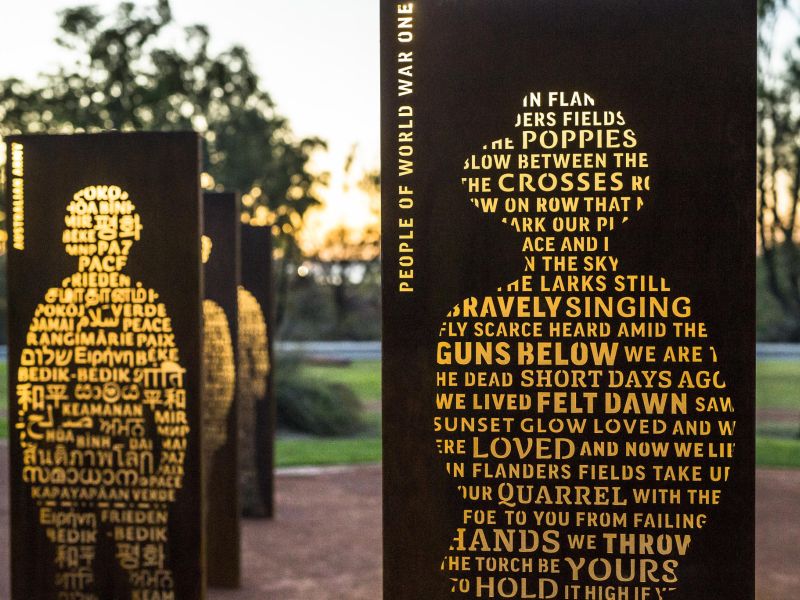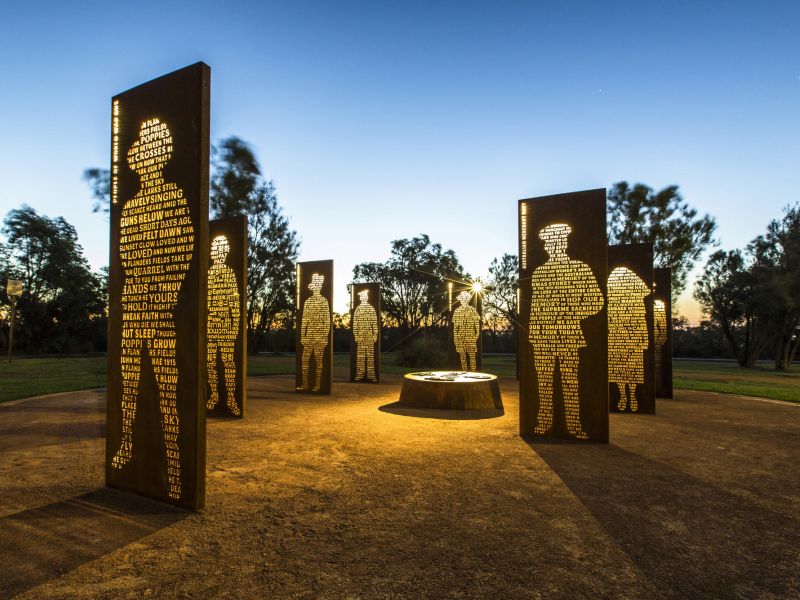Design elements of the City of Melville War Memorial
There are two sides to the memorial.
When viewed from a distance, the individual blades of the first side come together to form a single scene: a panoramic photograph from the Australian War Memorial Collection. This famous photograph was taken on the Western Front by James Francis Hurley on 5 October 1917. It shows supporting troops of the 1st Australian Division walking on a duckboard track near Hooge, in the Ypres Sector (Belgium). These troops were passing towards the front line to relieve their comrades, whose attack the day before won Broodseinde Ridge and deepened the Australian advance.
The second side depicts nine life-size silhouettes of individuals in uniforms dating from World War I to the present day. Each silhouette is formed by a pattern of words laser-cut from rusted steel.
In 2015, the City of Melville invited the community to submit stories, diary extracts, oral histories and poems about serving in the Australian Defence Force to be integrated as text into the design of the memorial.
Extracts from these texts were chosen for each panel in consultation with Applecross Returned and Services League (RSL) Sub-Branch members. While the memorial site as a whole is designed to accommodate large group ceremonies, the texts of the second side encourage personal moments of reflection from individual visitors.
There are nine figures:
1. People of World War I
‘In Flanders Fields’ by John McCrae, May 1915.
Recommended by the Applecross RSL and the community
2. People of World War II
Extract from ‘For the Fallen’ by Robert Laurence Binyon, September 1914.
Paragraph 1, ‘The Ode’, is a traditional recitation on Anzac Day.
Recommended by the Applecross RSL and the community
3. Royal Australian Navy
‘A Sailor’s Prayer’, by Petty Officer Henry Shipstone, who lost his life on the HMAS Sydney.
On 19 November, 1941, the Sydney was lost with the loss of all 645 Australians on board. It was the largest loss of life in the history of the Royal Australian Navy and the largest allied warship lost with all hands during World War II.
4. Royal Australian Air Force
A list of wars and conflicts Australia has been involved in since Federation in 1901
Sourced from: www.awm.gov.au/conflicts/
5. Australian Peacekeepers
A list of peacekeeping and humanitarian operations in which Australia has been involved
Sourced from: www.awm.gov.au/conflicts/
6. Australian Merchant Navy
Text submitted by the Applecross RSL and the community
7. Aboriginal and Islander Veteran
“Forgotten Australians” poem by Victor Churchill from Talking to an Aussie, WA, 2013
Recommended by Ron Bradfield
8. Australian Military Nurses
Extracts from the book Willingly Into the Fray: One Hundred Years of Australian Army Nursing (edited by Catherine McCullagh) and tributes from the community
9. Australian Army
The word “Peace” translated into 36 languages spoken within the City of Melville community

 City of Melville
City of Melville